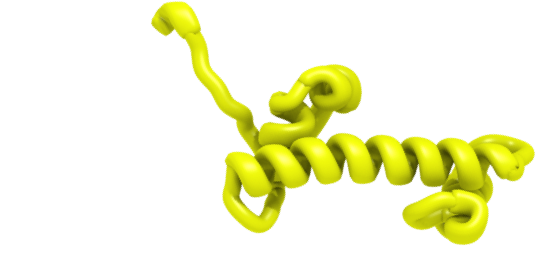
/ H2A / Variant: H2A.Z
Description
H2A.Z containing nucleosomes often localize near transcription start and enhancer regions, they are thought to be involved in Pol II recruitment, transcription regulation, DNA repair, suppression of antisense RNA. H2A.Z nucleosomes have a larger acidic patch, an amino acid insertion in α1-helix and one deletion in the docking domain compared to canonical H2A. The L1-loop region exhibits four amino acids difference between H2A.Z and canonical H2A and is likely involved in conferring stability and functional specificity of variant nucleosomes via L1-L1 interactions.Alternate names: D2, H2A.V, H2A.Z, H2A.Z-1, H2A.Z-2, H2A.Zc, H2Av, H2AvD, Htz1p, hv1, member Z
Features
Below, you can explore the features of H2A.Z from Homo sapiens, if available and how it compares to the canonical histones of the same type (first row). Canonical histone is shown in the first row, the names and descriptions of each feature can be found underneath. To explore variants from other species, please browse our curated sequences, automatically extracted sequences, or by taxonomy.
Keys: red - identical residues, blue - different residues (if more than one sequence).
Variant features
in
Approximate site of characteristic one amino acid insertion with respect to canonical H2A in L1-loop
>D
Characteristic substitution into Asp for many H2A.Z (excl. Trypanosoma), which increases the size of acidic patch.
del
Site of characteristic one amino acid deletion with respect to canonical H2A
General histone type features
alpha1ext
Alpha1-extension helix
alpha1
Alpha1-helix, first helix of histone fold
loopL1
L1 loop, connecting first and second helices of histone fold. Part of L1L2 DNA binding site formed by H2A and H2B at SHL ±3.5.
beta1
Beta-strand in L1L2 DNA binding site
R1
Minor groove arginine at L1L2 DNA binding site, SHL ±3.5
alpha2
Alpha2-helix, second helix of histone fold
ap
Acidic patch residues
loopL2
L2 loop, connecting second and third helices of histone fold. Part of L1L2 DNA binding site formed by H2A and H2B at SHL ±5.5.
R2
Minor groove arginine at L1L2 DNA binding site, SHL ±5.5
beta2
Beta-strand in L1L2 DNA binding site
alpha3
Alpha3-helix, third helix of histone fold
Docking domain
Docking domain locking H2A-H2B dimer on H3-H4 tetramer surface
alpha3ext
Alpha3-extension helix
beta3
Beta-strand between H2A and H4
References
- Talbert PB, Ahmad K, et al. "A unified phylogeny-based nomenclature for histone variants." Epigenetics Chromatin, 2012. PMID: 22650316
- Shaytan AK, Landsman D, et al. "Nucleosome adaptability conferred by sequence and structural variations in histone H2A-H2B dimers." Curr Opin Struct Biol, 2015. PMID: 25731851
- Suto RK, Clarkson MJ, et al. "Crystal structure of a nucleosome core particle containing the variant histone H2A.Z." Nat Struct Biol, 2000. PMID: 11101893
- Zlatanova J and Thakar A. "H2A.Z: view from the top." Structure, 2008. PMID: 18275809
- Horikoshi N, Sato K, et al. "Structural polymorphism in the L1 loop regions of human H2A.Z.1 and H2A.Z.2." Acta Crystallogr D Biol Crystallogr, 2013. PMID: 24311584
- Eirin-Lopez JM, Gonzalez-Romero R, et al. "The evolutionary differentiation of two histone H2A.Z variants in chordates (H2A.Z-1 and H2A.Z-2) is mediated by a stepwise mutation process that affects three amino acid residues." BMC Evol Biol, 2009. PMID: 19193230
- Nishibuchi I, Suzuki H, et al. "Reorganization of damaged chromatin by the exchange of histone variant H2A.Z-2." Int J Radiat Oncol Biol Phys, 2014. PMID: 24969791
- Bonisch C, Schneider K, et al. "H2A.Z.2.2 is an alternatively spliced histone H2A.Z variant that causes severe nucleosome destabilization." Nucleic Acids Res, 2012. PMID: 22467210
- Dryhurst D, Ishibashi T, et al. "Characterization of the histone H2A.Z-1 and H2A.Z-2 isoforms in vertebrates." BMC Biol, 2009. PMID: 20003410
- Soboleva TA, Nekrasov M, et al. "Histone variants at the transcription start-site." Trends Genet, 2014. PMID: 24768041
- Millar CB. "Organizing the genome with H2A histone variants." Biochem J, 2013. PMID: 23301656
- Talbert PB and Henikoff S. "Histone variants--ancient wrap artists of the epigenome." Nat Rev Mol Cell Biol, 2010. PMID: 20197778
A set of manually selected and validated histone sequences is listed in the table. Click on an entry in the table to update the annotated sequence preview: a variant will be compared with the canonical histone from the same species (if available).
Alternatively, tick mark the sequences and use toolbar to view MSA, export or add to basket. Use search or filters to find particular entries.
Keys: red - identical residues, blue - different residues (if more than one sequence). For feature legend see summary tab.
Sequence preview and annotation... LOADING
Min Score
Max Score
157.9
242.4
You selected: root
Note: variant classification might be ambigous between very similar variants. Classification scores against all variant models are available via advanced menu.
Features characteristic for a given histone type/variant are marked below the consensus sequence. For feature description see summary tabs of the corresponding variants pages.
Keys: red - 80% identical, blue - 50% identical columns. X-ambigous positions in consensus sequence.